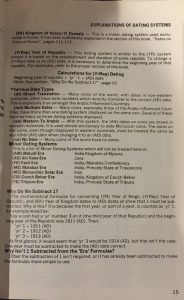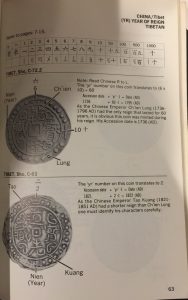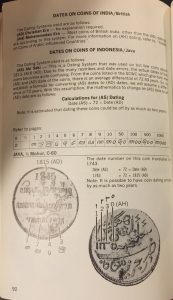Mar 3, 2019 | Britain, coins, news
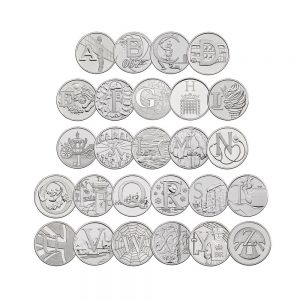
Royal Mint’s 26 Alphabet 10p Coins
Image courtesy of the Royal Mint
This is not to say these publications are wrong, but they are prone to hyperbole and exaggeration. Take for example the story “Two million RARE 10p coins enter circulation – get one here” that was posted to the Daily Star’s website this past week.
The title refers to the release of Royal Mint’s “The Great British Coin Hunt of 2019.” Using the same designs as last year, the Royal Mint will place into circulation 10 pence coins with 26 designs representing the letters of the alphabet.
The Great British Coin Hunt started last October with the weekly release of several coins at a time until 2.4 million were placed into circulation. As part of the program, collectors can purchase a special folder from the Royal Mint (£9.90 or about $13.10) or other items to help people collect the coins. The Royal Mint also sells uncirculated 10p coins for £2 each.
If you think that the U.S. Mint overcharges for their products, 10p is worth about 13-cents at the current exchange rate and £2 is about $2.65. Does packaging and other expenses cost $2.52 per coin?
But to call 2.4 million coins rare may a bit of an exaggeration.
Or is it?
If each coin has the same circulation, that means there will be about 92,000 coins per letter. Since the United Kingdom’s population is around 66 million people, that means only one-tenth of one percent of the people can collect these coins.
Maybe the tabloids are not wrong calling 2 million coins “rare!”
And now the news…
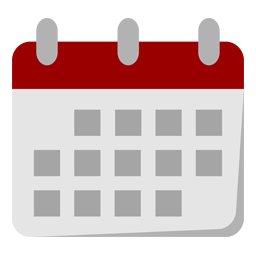
February 25, 2019
From dark designs mourning the dead, to figures celebrating military accomplishments and well-known buildings, Roman coins held by the Otago Museum… 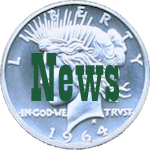 → Read more at odt.co.nz
→ Read more at odt.co.nz

February 26, 2019
Originally posted on http://www.1007sandiego.com/story/40029522/a-story-of-honor-the-curious-history-of-military-challenge-coins If you’re a member of the United States military,…  → Read more at kxxv.com
→ Read more at kxxv.com

February 26, 2019
FRESHLY minted collectable 10p coins are being released this month — and they have a “quintessentially British” theme including tea and fish and chips.  → Read more at dailystar.co.uk
→ Read more at dailystar.co.uk

February 27, 2019
THE ROYAL MINT have announced that they are set to release 26 new designs of 10 pence coins, for its 2019 Great British Coin Hunt collection.  → Read more at express.co.uk
→ Read more at express.co.uk

February 28, 2019
If you lost a coin in Montreal’s west end, there’s a good chance it was picked up by Young S. New. But he didn’t slip that coin in his pocket with the intent of spending it on himself — he picked it up so he could give it away.  → Read more at cbc.ca
→ Read more at cbc.ca

February 28, 2019
The nine British bullion coins were discovered by chance after being hidden near Allington Castle in Kent. Detectives have launched an appeal to return the hoard to its rightful owner.  → Read more at dailymail.co.uk
→ Read more at dailymail.co.uk
Mar 2, 2019 | coins, commemorative, investment, legislative
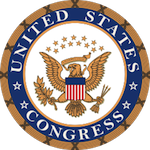 While the mainstream media has mostly been distracted by other activities in Congress, those of us who watch numismatic-related legislation have had our own action.
While the mainstream media has mostly been distracted by other activities in Congress, those of us who watch numismatic-related legislation have had our own action.
First, the House of Representatives passed Route 66 Centennial Commission Act (H.R. 66) to create a commission to celebrate the centennial of the famous Route 66 in 2026. Although this is not a numismatic-related bill per se, if passed, the bill says that the centennial commission will recommend commemorative coins for this event. The bill has been referred to the Senate Environment and Public Works Committee waiting further action.
The other legislation of note is the Monetary Metals Tax Neutrality Act of 2019 (H.R. 1089) that removes all tax considerations for the sale of “gold, silver, platinum, or palladium coins minted and issued by the Secretary at any time.” It also exempts “refined gold or silver bullion, coins, bars, rounds, or ingots which are valued primarily based on their metal content and not their form.” This means that no capital gains on the sale of these items will be taxed and no losses can be written off by the taxpayer.
An interesting side effect of this bill would be that the gains realized when rare coins auctioned for millions of dollars will not be taxed. This means if an 1804 Silver Dollar sells for more than the $3.8 million it sold for in 2013, the seller will not pay capital gains tax on the sale. However, if it sells for less, the seller will not be able to write-off the loss.
For those keeping score at home, this law will not help the sale of a 1913 Liberty Head Nickel since its composition is copper and nickel.
Of course, this will only be an issue if H.R. 1089 passes and the president signs it into law.
H.R. 66: Route 66 Centennial Commission Act
Summary: This bill establishes the Route 66 Centennial Commission to honor Route 66 on the occasion of its centennial anniversary.The Department of Transportation shall prepare a plan on the preservation needs of Route 66.
Received in the Senate and Read twice and referred to the Committee on Environment and Public Works. — Feb 7, 2019
Motion to reconsider laid on the table Agreed to without objection. — Feb 6, 2019
On motion to suspend the rules and pass the bill Agreed to by the Yeas and Nays: (2/3 required): 399 – 22 (Roll no. 67). — Feb 6, 2019
Considered as unfinished business. — Feb 6, 2019
At the conclusion of debate, the Yeas and Nays were demanded and ordered. Pursuant to the provisions of clause 8, rule XX, the Chair announced that further proceedings on the motion would be postponed. — Feb 6, 2019
DEBATE – The House proceeded with forty minutes of debate on H.R. 66. — Feb 6, 2019
Considered under suspension of the rules. — Feb 6, 2019
Ms. Norton moved to suspend the rules and pass the bill. — Feb 6, 2019
Referred to the House Committee on Transportation and Infrastructure. — Jan 3, 2019
H.R. 1089: Monetary Metals Tax Neutrality Act of 2019
Summary: Monetary Metals Tax Neutrality Act of 2019This bill exempts gains or losses from the sale or exchange of certain coins or bullion from recognition for income tax purposes. The exemption applies to gains or losses from the sale or exchange of (1) gold, silver, platinum, or palladium coins minted and issued by the Department of the Treasury; or (2) refined gold or silver bullion, coins, bars, rounds, or ingots which are valued primarily based on their metal content and not their form.
Referred to the House Committee on Ways and Means. — Feb 7, 2019
S. 457: President George H.W. Bush and Barbara Bush Coin Act
Read twice and referred to the Committee on Banking, Housing, and Urban Affairs. — Feb 12, 2019
H.R. 1173: President George H.W. Bush and Barbara Bush Dollar Coin Act
Referred to the House Committee on Financial Services. — Feb 13, 2019
H.R. 1257: To require the Secretary of the Treasury to mint coins in commemoration of the United States Coast Guard.
Referred to the House Committee on Financial Services. — Feb 14, 2019
S. 509: A bill to require the Secretary of the Treasury to mint coins in commemoration of the United States Coast Guard.
Read twice and referred to the Committee on Banking, Housing, and Urban Affairs. — Feb 14, 2019
Feb 26, 2019 | coins, commentary, news
The delay in reporting the weekly world numismatic news was because I worked at my first Comic Convention or Comic-Con. It was a small Comic-Con with between 60 and 80 vendors around a large hotel ballroom. Of course, each table had comics but others had different items related to the comics, science fiction, horror, pulp fiction, and similar works.
As with any of the shows that I have worked, there were the serious collectors with want lists who were laser-focused on finding that gem for their collection. There were the collectors and those with a general interest who were there for the experience. They were looking at different items for something unusual. Finally, there were those who were there for the cosplay. Cosplay is a portmanteau (combination) of the words costume play.
Aside from a visit by the likes of Darth Vader, Wonder Woman, and the Joker in the crowd, the best costume was the guy dressed as Iron Man. Ironically, the solid pieces of his costume were made from wood. It looked good but the wood seems odd given the character.
What does my experience at the Comic-Con have to do with numismatics? It is a type of show that demonstrates how other hobbies adapt with their audience to lure new collectors. Rather than concentrating on making sure that every collector has the latest special edition of the No. 1 copy of the current story with their favorite character, it promotes fun, interaction, and does not judge each other because someone does not collect the four special covers of the No. 1 copy just issued by the comic book designer.
-
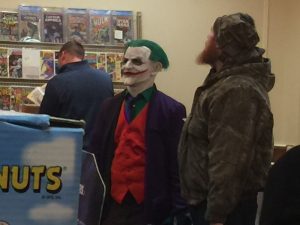
-
There’s always a Joker in every crowd!
-
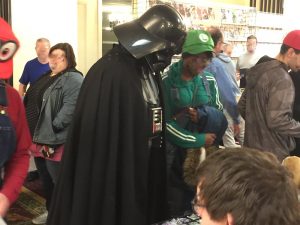
-
A visit by Lord Vader himself!
Numismatics claims to be all inclusive but if you ask most dealers what to collect, they will gravitate to most of the same answers. If they are not pushing gold the number of Morgan dollars in their cases is an indication of their preference.
There are too many people with set ideas of what makes a good collection. And the problem is that the dealers are the wrong people to ask. They have an agenda over the perpetuation of the hobby. There is nothing wrong with that agenda because it contributes to their livelihood and the well being of their employees. Unfortunately, too many dealers pay lip service to the notion of collect what you like while pushing the latest set of VAMs on you.
While thinking about the show as I was driving away with half-empty bins of inventory was that if the hobby was more inclusive to people who do not collect high-end merchandise. People have different tastes and there should be more dealers who not only cater to those tastes but should be given better access.
Speaking of the dealers, if they want to be more inclusive and show consideration for the collectors they should stay until the close of a show on Sunday. When I participate in the many antique shows, flea markets, toy shows, sports shows, and now this Comic-Con, dealers are warned that if they pack up and leave early they may not be allowed to set up at a future show. Numismatic shows say this, including those sponsored by the ANA, but nobody follows through. Then we get a situation like in Baltimore where it is not worth attending on Sunday, my only day off this week.
Finally, something should be done to make the shows fun. While I am not suggesting that people get dressed up like at the Comic-Con, there has to be something to make it fun. For example, the last time I attend the F.U.N. show, there were tables set up where Hobo Nickel artists were carving coins and making jewelry on the show floor. That was fun!
Although there are dealers who give out low-value coins to young collectors, can we do something to make the show more fun for the casual collector? Does everything have to be about buying the next piece of stickered plastic that happens to have a coin inside?
There have been some successful promotions including a chance to win an autographed Red Book but what about a drawing for a gift certificate? Hire a magician to do some coin magic to intrigue people. What about a walking exhibit where an expert in a non-mainstream area walks around and starts with, “Hey, let me tell you a story…” which involves taking a coin and talking about it beyond its grade. I am sure that someone can take a handful of tokens representing the area of the country where the show is and tie it with local history.
Numismatics is not dying, but it is not adapting. Maybe if the shows can be made into a real event then more people would be willing to collect. Remember, the Comic-Con had aisles full of people on a Sunday, more than will attend the Whitman Show in Baltimore next week!

The view standing In the middle of Hall A at the Baltimore Convention Center for the March 25, 2018 Whitman Expo.
Is this the fate of numismatics?
And now the news…

February 19, 2019
A TEAM of metal detectorists in a field near Malvern had a 'lottery winning' moment as they found a hoard of rare 17th Century coins.  → Read more at worcesternews.co.uk
→ Read more at worcesternews.co.uk

February 19, 2019
Coins were buried in a ceramic pot under the floor of a building, Warwickshire County Council said.  → Read more at bbc.com
→ Read more at bbc.com

February 20, 2019
The 14th Century coin was discovered inside one of three hidden drawers in a wooden bureau.  → Read more at bbc.com
→ Read more at bbc.com

February 20, 2019
The Bangko Sentral ng Pilipinas on Tuesday warned the public against improper handling of peso bills and coins. Current trending headlines in business, money, banking, finance, companies, corporations, agriculture, mining, foreign currency rates, Philippine Stock Exchange (PSE) Index, inflation, interest, market prices and economic analysis.  → Read more at gmanetwork.com
→ Read more at gmanetwork.com

February 21, 2019
Danny Bostock is accused of killing rival Gordon McGhee during bungled burglary  → Read more at theweek.co.uk
→ Read more at theweek.co.uk

February 21, 2019
The 14th Century coin was discovered inside one of three hidden drawers in a wooden bureau.  → Read more at bbc.com
→ Read more at bbc.com

February 21, 2019
A Burnsville man and former coin dealer has pleaded guilty to fraud charges in federal court. Barry R. Skog, 68, pleaded guilty Thursday to one count of mail fraud and one count of selling counterf…  → Read more at twincities.com
→ Read more at twincities.com
Feb 21, 2019 | books, coins, foreign
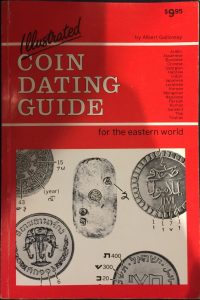 Over the last few months, I have been on another book buying binge. Most of the books I have been buying are references. Many of these references help fill in some of the gaps in my knowledge. One of those gaps is how to date some foreign coins especially those of the eastern world whose language is not Latin-based.
Over the last few months, I have been on another book buying binge. Most of the books I have been buying are references. Many of these references help fill in some of the gaps in my knowledge. One of those gaps is how to date some foreign coins especially those of the eastern world whose language is not Latin-based.
Although the Standard Catalog of World Coins has a basic reference to help figure out the date of a coin, it is not detailed enough. While there are websites on the Internet to help, there is not a single good resource. I wanted a good resource to help me grade these coins. Then I stumbled across the Illustrated Coin Dating Guide of the Eastern World by Albert Galloway.
Published by Krause Publications, it features the tables and descriptions that are in the Standard Catalogs on steroids plus much more information. The absolute best part of this book are the images with the guides pointing to each element to help identify the date coin.
Some coins are not dated but contain the number of years of the current ruler or dynasty. Coins from Israel use the date on the Hebrew Calendar while many Islamic countries include the date of the Islamic or Hijri Calendar.
Sample Pages
And it helps in more ways than figuring out the dates. If you are not familiar with the pictograph-style writing of some East Asian countries, having in the information in front of you can help identify the difference between a Korean coin from a Japanese coin, something that recently helped me.
Also, the book points out how to identify elements like mintmarks, privy marks, coiners marks, and other identifying varieties on these coins. As we know, a mintmark or other distinguishing mark can make a difference in a coin’s value.
The book was first published in 1984 and republished in 2012. Both versions appear to be the same with a color variation of the cover—the 1984 publication has a predominantly red cover.
The only complaint about the book is that it should be spiral bound so that the book could lay flat on the table. I have not had the book long and I have already bent the spine. At this rate, the book may not last long. For that reason, I give the book a grade of MS-69. If you are searching through lots of foreign coins, this book is a must-have for your numismatic library.
Feb 17, 2019 | coins

(Image courtesy of Bellingham Coin Shop)
Prizes range from cash to coins to estate finds. It piques the interest of those around the Bellingham area.
For those not familiar with Bellingham, it is the last city in the United States as you travel north on Interstate 5 toward the Canadian border. I made that drive in June 1998 and stopped in Bellingham before crossing the border. It was a nice place for the few hours we spent there. After a nice lunch as a short walk, we continued our trip saying we should return.
Even though Bellingham is a small city, it can serve as a lesson to a lot of other numismatists and dealers. What better way to promote yourself and the hobby than a treasure hunt. Sure, there have been reports of coin drops, but with those, you run the risk of the coin not being found and continuing its journey through the banking system.
A treasure hunt, like geocaching, can be fun. Instead of relying on the special equipment that most geocaching hunts require, you make it like a scavenger hunt with clues posted on social media. It is a way to cultivate followers and potential clients.
It can also be a tool to have people learn more about coin collecting. Rather than hide a coin that someone may throw into a draw, how about a certificate to let them come into your shop to get them started on collecting. Dealers can start new clients with an affordable collection that can be used to promote an interest in collecting.
This is such a good idea that I am thinking about using it for my business. Except I will wait until the weather is a little warmer!
And now the news…

February 11, 2019
An Israeli tour guide and her friend last week stumbled across a rare 1,900-year-old coin from the time of the Bar Kochba revolt unearthed by recent rains in the Lachish region, southwest of Jerusalem, the Israel Nature and Parks Authority said Monday.  → Read more at timesofisrael.com
→ Read more at timesofisrael.com

February 13, 2019
FOLLOWING on from a recent warning that went viral in Spain police have warned of more foreign coins in circulation that look similar to one and two euro  → Read more at euroweeklynews.com
→ Read more at euroweeklynews.com

February 15, 2019
John Herrington is looking forward to his new pocket change. A former NASA astronaut who was the first enrolled member of a Native American tribe to fly into space, Herrington is among those celebrated by the U.S. Mint's 2019 Native American $1 coin.  → Read more at collectspace.com
→ Read more at collectspace.com

February 15, 2019
Nature and Parks Authority tour guide stumbles on 1,885-year-old find while on training hike in Lachish region  → Read more at timesofisrael.com
→ Read more at timesofisrael.com

February 15, 2019
An amateur metal detectorist has compared finding a 6th century Anglo-Saxon pendant in a muddy field to 'winning the lottery'. The shiny piece of gold was originally mistaken to be a 'chocolate coin' due to its immaculate preservation but experts proved it is a gold pendant from 1,500 years ago.  → Read more at dailymail.co.uk
→ Read more at dailymail.co.uk

February 15, 2019
Three straight days of snow have been a pain in the neck, but if you haven’t taken the chance to go out and play in it, you might want to consider this. R.B. Wick, the owner of Bellingham Coin Shop & Iron Gate Estates who is known for his love of creating treasure hunts around Bellingham and posting clues on his various social media accounts, has another treasure hunt going in honor of Valentine’s Day.  → Read more at bellinghamherald.com
→ Read more at bellinghamherald.com
Feb 10, 2019 | coins, news, US Mint
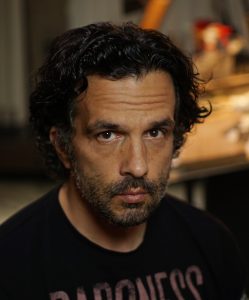 The numismatic news of the week of the week is the appointment of Joseph Menna as the 13th Chief Engraver of the U.S. Mint.
The numismatic news of the week of the week is the appointment of Joseph Menna as the 13th Chief Engraver of the U.S. Mint.
Although the position of Chief Engraver was abolished in 1996 as an appointed position, Mint Director Edmund Moy resumed the position and appointed John Mercanti as the 12th Chief Engraver. The position was vacant since Mercanti’s resignation in 2010.
Many references cite Public Law 104-208 as the law that eliminated the Chief Engraver position. That bill is the Omnibus Consolidated Appropriations Act of 1997. As with a lot of these omnibus acts, there is a lot of “stuff” packed into this law, but there does not appear to be a reference to the Chief Engraver.
In fact, a search the term “chief engraver” at govinfo.gov, the site for the Government Printing Office shows no public or private law with those words. The GPO has nearly every bill and public law for the past 100 years available for full-text search.
This is something to look into.
In the mean time, congratulations Joe Menna!
And now the news…

January 30, 2019
A 300-year-old British coin has sold at auction for a world-record price of £845,000. The five guinea 'Vigo' coin dates to 1703 and was made using gold seized by the British from a Spanish treasure ship at the Battle of Vigo Bay.  → Read more at dailymail.co.uk
→ Read more at dailymail.co.uk

February 3, 2019
MANCHESTER, N.H. — Hundreds of students took part Saturday in a robotics competition at Southern New Hampshire University. And the event came with an assignment from inventor Dean Kamen: He wants every student to get involved with an effort to honor a New Hampshire hero.  → Read more at wmur.com
→ Read more at wmur.com

February 5, 2019
More than a decade ago Aries Cheung, a Toronto-based artist, graphic designer and filmmaker, was approached by a representative from the Royal Canadian Mint. Would he like to enter a competition for a new series of coins to celebrate the Lunar New Year?  → Read more at scmp.com
→ Read more at scmp.com
Feb 3, 2019 | coins, commentary, grading, news
Sorry for being late, but there was this boring football game on. And the commercials stunk, too!
A story that resonated with me was from the American Physical Society that discussed research being done in Germany that could digitally examine coins.
Currently, the research is using ancient coins stored by their local heritage society. The purpose is to aid in the identification of the coins and to maintain an accurate description of these coins.
Although there have been similar attempts including smaller programs, this appears the first attempt to use computer imaging on a large scale to analyze the characteristics of coins. If it is successful, the imaging can also be used to determine the grade of coins.
-
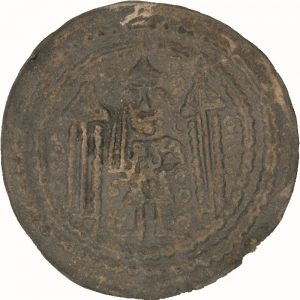
-
The coin as it appears without digital enhancement
-
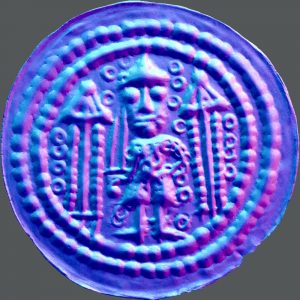
-
When the coin is imaged, the imaging software analyzes the surface to highlight its features
-
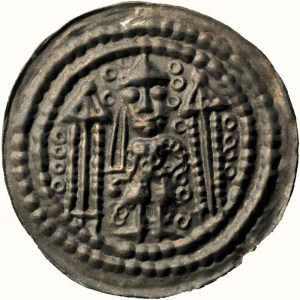
-
A computer representation of the coin as it might have looked when it was originally struck.
Yes, I am saying that computers can do the grading of coins and probably do a better job than humans.
Computer imaging has come such a long way that it is an enhancement to almost everything that requires visual work. Nothing is more impressive than the system that uses medical imaging to virtually recreate a surgery scene so that a doctor and team can practice the most delicate surgery before cutting open the patient. Imaging can see beyond blood, organs, and even ordinary body fat to guide instruments through the body allowing for minimally invasive surgery.
Those of us with a smart telephone in our pocket that was purchased within the last three years has a device with the imaging capabilities and computing power that is equivalent to those used in those medical situations.
We can perform medical miracles, detect people from satellites thousands of miles in space, and even capture clear images of someone committing a crime with a phone from your pocket but the numismatic industry pedantically resists the use of computer imaging to grade coins.
The problem is that computer imaging will disrupt the status quo and make the grading services nearly obsolete if it was an acceptable way of analyzing coins. Dealers would lose their advantage of being the experienced eye looking at coins.
The result will be a consistency in coin grading that is not available today.
Think about it. There would be no need for crossovers, crack-outs, or a fourth-party sticker service that is nothing more than an arbitrage system to drive prices up. Collectors would be in control. Take out your phone and scan the coin. It will tell you the grade. And it will be the same grade whether I do the scan or if you do.
Computers do not like. Computers do not have emotions. Computers do not have an agenda. Take the picture, analyze, and provide a result. It puts the power in the hands of the collectors.
Of course, putting the power in the hands of the collectors is not what the dealers want. It is not what the grading services want. Computer imaging will disrupt their business.
And now the news…

January 29, 2019
During school field trip, student finds coin bearing the inscription "King Agrippa."  → Read more at israelnationalnews.com
→ Read more at israelnationalnews.com

January 30, 2019
At the same time, the number of fake banknotes has dropped.  → Read more at spectator.sme.sk
→ Read more at spectator.sme.sk

January 30, 2019
The County  → Read more at thecounty.me
→ Read more at thecounty.me

January 31, 2019
The massive medallion, made of the purest gold bullion ever refined and worth $5.8 million, was stolen from the Bode Museum in Berlin—and has never been found  → Read more at macleans.ca
→ Read more at macleans.ca

February 1, 2019
A new exhibit at a landmark Vermont museum showcases the work of a renowned artist who calls New England Home. In his Windham County workspace, Johnny Swing transforms quarters, half dollars, and other…  → Read more at nbcboston.com
→ Read more at nbcboston.com

February 1, 2019
Countless historical coins that differ from each other only in details are in storage at German state museums. Unlike paintings, these archaeological artifacts may not be labeled, marked or barcoded. Researchers at the Fraunhofer Institute for Factory Operation and Automation IFF developed a scanner and analysis software in collaboration with the Saxony-Anhalt State Office for Heritage Management and Archaeology, which digitally capture the visual features of coins and describe them exactly in a matter of seconds. The scanning system can be used to identify and recognize coin finds.  → Read more at phys.org
→ Read more at phys.org
Feb 1, 2019 | coins, commemorative, legislative
 At noon on January 3, 2018, the 116th Congress gaveled into session. The first day of a new congressional session is mostly ceremonial and procedural. Leaders are chosen. Rules are established. Committees are formed. And the House of Representatives gets to work on a new budget.
At noon on January 3, 2018, the 116th Congress gaveled into session. The first day of a new congressional session is mostly ceremonial and procedural. Leaders are chosen. Rules are established. Committees are formed. And the House of Representatives gets to work on a new budget.
Usually, the budget the House starts with is for the next fiscal year. This year, the 115th Congress did not finish their work and left the government unfunded. It does not matter whose side you are on or what animal you worship, the bottom line is that 800,000 federal employees, many more contractors, and the businesses that rely on their patronage were hurt. Sure, the federal employees will earn back pay but the contractors who were furloughed will not. The businesses that serve these people will also not be made whole.
But that did not stop members of Congress from submitting bills for consideration. As I write this, there have been 842 bills submitted in the House of Representatives and 268 in the Senate. Of those bills, only four have numismatic significance. All four bills were also submitted in the 115th Congress but had died in committee when that Congress adjourned for the final time.
As of now, the Financial Services Committee, chaired by Rep. Maxine Waters (D-CA), has not posted the rules as to what it will take for numismatic-relation legislation to move forward. Since the 112th Congress, the committee required a numismatic bill to have 250 co-sponsors. But since the control of the committee has changed parties, we will have to wait until the committee publishes their rules.
Here are the first four numismatic-related bills submitted in the 116th Congress:
H.R. 61: Carson City Mint 150th Anniversary Commemorative Coin Act of 2019
Summary: This bill directs the Department of the Treasury to mint and issue $5 gold coins and $1 silver coins in commemoration of the 150th anniversary of the Carson City Mint in Carson City, Nevada.All surcharges from sales of such coins shall be paid to the Nevada State Museum Dedicated Trust Fund.
Referred to the House Committee on Financial Services. — Jan 3, 2019
H.R. 500: Christa McAuliffe Commemorative Coin Act of 2019
Referred to the House Committee on Financial Services. — Jan 11, 2019
H.R. 636: To require the Secretary of the Treasury to mint coins in commemoration of Muhammad Ali.
Referred to the House Committee on Financial Services. — Jan 17, 2019
S. 239: A bill to require the Secretary of the Treasury to mint coins in recognition of Christa McAuliffe.
Read twice and referred to the Committee on Banking, Housing, and Urban Affairs. — Jan 28, 2019
Jan 29, 2019 | coins, education, Euro, foreign
After my last post about the Staatliche Münze Berlin, the Berlin State Mint, a few German readers provided a lesson in the political structure of Germany to understand the institution’s role in the country’s coin production.
Unlike what I wrote previously, the Berlin State Mint is a government mint but for the government of the Federal State of Berlin.
Berlin is one of two cities that is also designated as a state. The other is Hamburg. The divisions trace back to the many small states that existed in the region during the days Holy Roman Empire. In short, it was an attempt to bring unification to the region by attempting to allow each smaller states, kingdoms, principalities, cities, etc. to provide their own rule for the common good. Some reference suggests that there were over 300 individual governments with their own governing rules at the height of the Empire.
Arguments, wars, and Napolean brought about many changes where many of the smaller states merged into larger ones and others changed by conflict. Following the Treaty of Versailles that ended World War I, Germany was forced to give up territories that left the current state boundaries were mostly set as they are today.
Before I hear from our German friends, I am leaving out a lot of history on purpose. I just want enough to bring context to the discussion. If anyone wants a more detailed discussion about the history as it pertains to the German mints, I recommend reading the article “
Why Germany has Five State-Owned Mints.”
Although the Third Reich tried to unify the country around a federal government, there were a number of administrative functions left to the states including the minting of coins and printing of currency. Even Adolph Hitler learned that to keep his version of an orderly government, he had to work with each of the states.
Following World War II, the concept of the confederation of states continued with the formation of the Federal Republic of Germany (West Germany) and the German Democratic Republic (East Germany). Although the federal government has evolved with more central power, the states continue to have a degree of independence in their operations that a person with a background in United States history would consider a confederation.
As the country evolved and times mandated change, many of the mints were closed. Production consolidated with the changes in the political structure of Germany. Following the unification of Germany in 1990, only five state mints remained:
NOTE: First letter on the line is the mintmark associated with the mint.
-

-
Berlin State Mint
-

-
State Mint of Baden-Wuerttemberg, Munich
-

-
Barvarian Main Mint, Stuggart
-
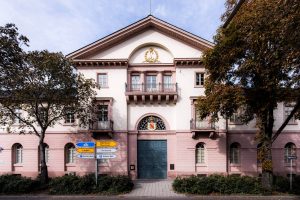
-
State Mint Baden-Wuerttemberg, Karlsruhe
-

-
Hamburg Mint
When the euro was introduced, German law mandated that the minting of the euro coins would be distributed evenly among the five mints. Any production beyond the federally mandated requirement to produce the euro is between the mint and the Finance Minister of the state.
As for the currywurst coin, although it is produced by the Berlin State Mint, it is a product of that mint and not a product endorsed by the German federal government.
If you are confused you are in good company. Even after spending parts of three days looking into the history, I am not sure I am right. It is more confusing than the structure behind the U.S. Mint!
Images of the Germany state mints are courtesy of the mints via their websites.
Jan 27, 2019 | coins, foreign, news
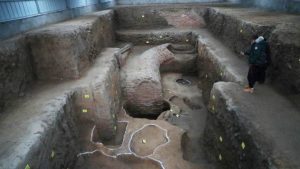
Archaeologists found fragments of ceramic coin moulds at the site when they were carrying out repairs after heavy rain in late 2017.
(Photo: South China Morning Post)
With only a portion of the facility excavated, the archeologists found nine areas that could have been used as part of coin production. There was one kiln site that was likely used to create porcelain coin molds and eight ash pits. They also found copper coins, coin mold fragments, and other items that were used as part of the coining process.
The China Numismatic Society told news sources that the inscriptions on the molds date the facility to 9-23 AD and corresponds to the reign of Wang Mang of the Han Dynasty.
Finds like this shows how the use of money and numismatics can lead to better understanding of societies what may have been lost.
And now the news…

January 18, 2019
It’s been dubbed one of the loveliest coins ever minted and, almost two centuries after it was struck, it’s making headlines again. A rare gold five pound coin, featuring an idealised image of Queen Victoria in the early years of her reign, has sold for a six-figure sum at a private auction.  → Read more at royalcentral.co.uk
→ Read more at royalcentral.co.uk

January 21, 2019
Archaeologists discover fragments of ceramic moulds, copper coins and a kiln site where an ancient government office once stood  → Read more at scmp.com
→ Read more at scmp.com

January 22, 2019
“There used to be this thing called money,” people will say in the future. And children will laugh. “You’re joking,” they’ll say.  → Read more at bostonglobe.com
→ Read more at bostonglobe.com

January 23, 2019
Secret Service members are reportedly exchanging challenge coins that take a jab at the ongoing partial government shutdown.  → Read more at thehill.com
→ Read more at thehill.com

January 23, 2019
The best-known U.S. Mint building in San Francisco is at Fifth and Mission streets, right across the street from the Chronicle building. The Old Mint is an imposing classical structure, but it’s been retired as a money-making plant for more than 80 years. By the early 1930s, the building was too antiquated to meet the increased demand for coins. So the U.S. Treasury found a second location, at Duboce and Buchanan streets, where a natural rock promontory could function as another layer of security. A search through The Chronicle’s archive uncovered photos of the construction of the New Mint in 1936, as well as the coin production work happening inside.  → Read more at sfchronicle.com
→ Read more at sfchronicle.com

January 25, 2019
The Royal Canadian Mint has uncovered the identity of the soldier who inspired its new silver dollar coin, which commemorates the sacrifice of Canadian soldiers on D-Day.  → Read more at cbc.ca
→ Read more at cbc.ca

January 25, 2019
A 10-year-old Indian boy who lives in Oman has collected more than 500 coins from across 120 countries.  → Read more at timesofoman.com
→ Read more at timesofoman.com
 → Read more at odt.co.nz
→ Read more at odt.co.nz → Read more at kxxv.com
→ Read more at kxxv.com → Read more at dailystar.co.uk
→ Read more at dailystar.co.uk → Read more at express.co.uk
→ Read more at express.co.uk → Read more at cbc.ca
→ Read more at cbc.ca → Read more at dailymail.co.uk
→ Read more at dailymail.co.uk
 While the mainstream media has mostly been distracted by other activities in Congress, those of us who watch numismatic-related legislation have had our own action.
While the mainstream media has mostly been distracted by other activities in Congress, those of us who watch numismatic-related legislation have had our own action.



